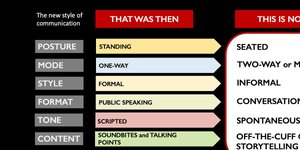
The 6 New Rules of Communicating

This contrast between the interactive content that “people crave” and the “traditional media” that has become outmoded has taken on a political cast since the election. In a New Yorker item, Joshua Rothman argues that “Democrats preach while Republicans riff” — i.e. Democrats operate like the nattering nabobs of traditional media while Republicans
... See moreRob Horning • Another Four Miles
The Internet made us allergic to Corporate Speak. The age of polish is over. The people crave raw sincerity now, and they're willing to put up with the mistakes.
Look at Elon Musk. His track record is filled with gaffes and blunders, but you can feel his passion in the tweets. Readers want to feel the fire.... See more
David Perellx.com